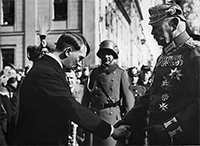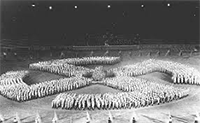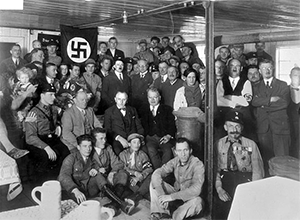The Rise of the Nazi Party
Part 3: Takeover and Crackdown
Hitler ran for President against Hindenburg in March 1932. No candidate got a majority and so the election proceeded to a runoff. Hindenburg garnered 49 percent of the vote in the first round, with Hitler getting 30 percent. Hitler improved to 37 percent in the runoff, but Hindenburg's 53 percent was enough to secure him re-election. In their first election contested, in 1924, the Nazi Party had garnered less than 1 percent of the vote. As late as 1928, the party won only 2.6 percent of the national vote. Governing the country during this time was a coalition of left-leaning political parties that included the Social Democratic Party, the Center Party, and the German Democratic Party. But in the wake of the Great Depression, the Nazi Party provided an outlet for many people to vent their frustrations at the government and at the rest of the world. Reichstag elections in 1932 resulted in the Nazi Party's taking the most seats by a wide margin. They did not have a majority, but they had a large voice. Then-Chancellor Franz von Papen called for yet another election, in November; the result was the same. 
President Hindenburg named Hitler as Chancellor on Jan. 30, 1933. Less than a month later was the Reichstag fire. Hitler convinced Hindenburg to sign the Fire Decree, suspending civil liberties throughout the country. In new elections, the Nazi Party won a majority. Soon, the new government had passed the Enabling Act, removing lawmaking powers from the Reichstag and giving them to the top-level government. As well, all political parties but the Nazi Party were banned; prohibited as well were labor unions. The national government took over running of the states. 
Hindenburg battled cancer but lost, dying on Aug. 2, 1934. The day before, Hitler and his Cabinet had passed a law abolishing the office of President and merging its powers with that of the Chancellor. When Hindenburg died, the republic died as well. In its place was a Germany run and increasingly controlled and dominated by Hitler and the Nazi Party. First page > Rough Beginnings > Page 1, 2, 3 |
|
Social Studies for Kids
copyright 2002–2025
David White



 By 1930, the party had representation well beyond its base in Bavaria. Economically and politically dispossessed people in other parts of the country rallied to the Nazi cause. Hitler was the prime mover of the party; attached to him were other senior party officials such as Joseph Goebbels and Hermann Göring. Rudolf Hess had the title of Deputy Leader, but the other senior officials did most of the talking and acting.
By 1930, the party had representation well beyond its base in Bavaria. Economically and politically dispossessed people in other parts of the country rallied to the Nazi cause. Hitler was the prime mover of the party; attached to him were other senior party officials such as Joseph Goebbels and Hermann Göring. Rudolf Hess had the title of Deputy Leader, but the other senior officials did most of the talking and acting.
